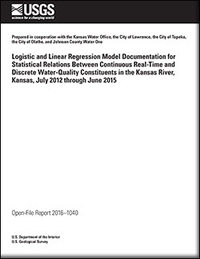Logistic and linear regression model documentation for statistical relations between continuous real-time and discrete water-quality constituents in the Kansas River, Kansas, July 2012 through June 2015
Links
- Document: Report (830 kB pdf)
- Appendix: Appendixes 1 through 31 (pdf)
- Download citation as: RIS | Dublin Core
Abstract
The Kansas River is a primary source of drinking water for about 800,000 people in northeastern Kansas. Source-water supplies are treated by a combination of chemical and physical processes to remove contaminants before distribution. Advanced notification of changing water-quality conditions and cyanobacteria and associated toxin and taste-and-odor compounds provides drinking-water treatment facilities time to develop and implement adequate treatment strategies. The U.S. Geological Survey (USGS), in cooperation with the Kansas Water Office (funded in part through the Kansas State Water Plan Fund), and the City of Lawrence, the City of Topeka, the City of Olathe, and Johnson County Water One, began a study in July 2012 to develop statistical models at two Kansas River sites located upstream from drinking-water intakes. Continuous water-quality monitors have been operated and discrete-water quality samples have been collected on the Kansas River at Wamego (USGS site number 06887500) and De Soto (USGS site number 06892350) since July 2012. Continuous and discrete water-quality data collected during July 2012 through June 2015 were used to develop statistical models for constituents of interest at the Wamego and De Soto sites. Logistic models to continuously estimate the probability of occurrence above selected thresholds were developed for cyanobacteria, microcystin, and geosmin. Linear regression models to continuously estimate constituent concentrations were developed for major ions, dissolved solids, alkalinity, nutrients (nitrogen and phosphorus species), suspended sediment, indicator bacteria (Escherichia coli, fecal coliform, and enterococci), and actinomycetes bacteria. These models will be used to provide real-time estimates of the probability that cyanobacteria and associated compounds exceed thresholds and of the concentrations of other water-quality constituents in the Kansas River. The models documented in this report are useful for characterizing changes in water-quality conditions through time, characterizing potentially harmful cyanobacterial events, and indicating changes in water-quality conditions that may affect drinking-water treatment processes.
Suggested Citation
Foster, G.M., and Graham, J.L., 2016, Logistic and linear regression model documentation for statistical relations between continuous real-time and discrete water-quality constituents in the Kansas River, Kansas, July 2012 through June 2015: U.S. Geological Survey Open-File Report 2016–1040, 27 p., https://dx.doi.org/10.3133/ofr20161040.
ISSN: 2331-1258 (online)
Study Area
Table of Contents
- Abstract
- Introduction
- Purpose and Scope
- Description of Study Area
- Methods
- Results of Logistic Regression Analysis for Cyanobacteria and Associated Compounds
- Results of Linear Regression Analysis for Selected Constituents
- Summary
- References Cited
- Tables
- Appendixes 1–31
| Publication type | Report |
|---|---|
| Publication Subtype | USGS Numbered Series |
| Title | Logistic and linear regression model documentation for statistical relations between continuous real-time and discrete water-quality constituents in the Kansas River, Kansas, July 2012 through June 2015 |
| Series title | Open-File Report |
| Series number | 2016-1040 |
| DOI | 10.3133/ofr20161040 |
| Publication Date | April 06, 2016 |
| Year Published | 2016 |
| Language | English |
| Publisher | U.S. Geological Survey |
| Publisher location | Reston, VA |
| Contributing office(s) | Kansas Water Science Center |
| Description | Report: iv, 27 p.; 31 Appendixes |
| Country | United States |
| State | Kansas |
| Other Geospatial | Kansas River |
| Online Only (Y/N) | Y |
| Additional Online Files (Y/N) | Y |


